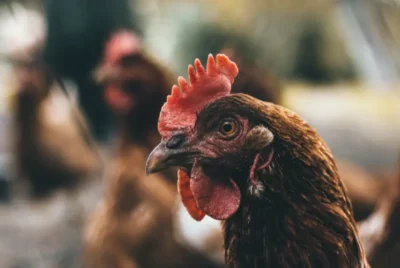Buff Brahma Chicken: Size, Traits, and Care Guide
Are you finding it challenging to understand the unique needs of your Buff Brahma Chicken breed? Are their size and distinct traits making it hard for you to provide the right care? Perhaps you’re overwhelmed by inconsistent information online, or you’re not sure how to maximize their potential as a breed.
In this comprehensive guide, we will address these common issues head-on, providing you with accurate, easy-to-follow advice that will make caring for your Buff Brahma Chickens a lot less stressful and a lot more rewarding.
Quick Overview
- Suitable for Beginner: Yes.
- Lifespan: 8+ years.
- Weight: Hens (10lb) Roosters (12lb).
- Feather Color: Buff.
- Egg Production: 3 eggs per week.
- Egg Color: Brown.
- Broody Tendencies: Sometimes.
- Child-Friendly: Yes.
- Chicken Cost: Starting at $5 per chick.
What is Buff Brahma Chicken Breed?
The Buff Brahma Chicken is a variety of the Brahma breed, developed in the United States from birds imported from Shanghai, China. Known for their large size and golden buff and black feathering, Buff Brahmas were the principal meat breed in the U.S. from the 1850s to 1930.
Their hardiness, good egg-laying ability, and docile temperament, coupled with their ability to withstand cold climates, make them a popular choice among poultry farmers and hobbyists.
Buff Brahma Chicken History
The history of the Buff Brahma is rich and complex, starting with its development in the United States from “Shanghai” birds imported from China. Its unique head shape and pea comb are thought to result from limited cross-breeding with Chittagong chickens from Bangladesh, setting the Brahma apart from the Cochin, another breed that originated from “Shanghai” birds.

The breed gained international recognition when Brahmas were sent to England as a gift for Queen Victoria in 1852. English breeders cultivated the Dark and Light Brahma variety and later re-exported it to the United States. The Light and Dark Brahma was included in the first British Poultry Standard in 1865 and the American Standard of Perfection in 1874.
The Buff Brahma, the variety we know today for its golden buff and black feathering, was added to the American Poultry Association in the early 20th century. From the 1850s to 1930, the Brahma was the primary meat breed in the U.S., with some birds reaching impressive weights of up to 18 lbs for cocks and 13 lbs for hens.
Physical Overview of Buff Brahma Chicken
Physical Characteristics
Beyond their size and plumage, Buff Brahma have a distinctive feather pattern called ‘beetle green,’ a unique iridescent black sheen in their black feathers. They have a yellow beak, while their eyes are a shade of dark brown, almost black.
The legs are strong and feathered, with four toes on each foot. The large wings and wide, well-rounded tails complete their overall grand stature.
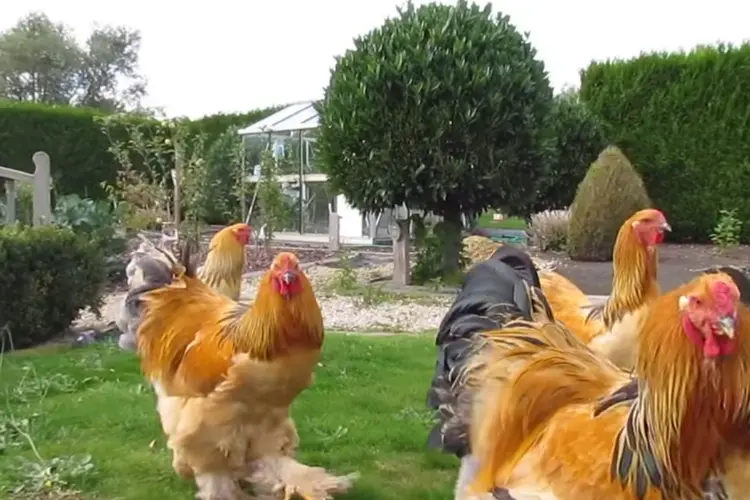
Dimensions and Mass
Given their large size, they require spacious coops and yards. Despite their size, they cannot fly, making lower fencing acceptable. It’s also worth noting that due to their size, Brahmas are slow to mature, reaching their full size later than many other breeds.
Feather Color
The golden buff color of these chickens is warm and rich, providing a beautiful contrast with the black areas. This color combination not only makes them stand out in the flock but also makes them a very visually appealing breed. They are usually seen as show birds due to their distinct coloration and impressive appearance.
Traits of Buff Brahma Chicken
Temperament
Buff Brahma Chickens are calm and have a friendly temperament. They are typically docile breed or non-aggressive, which makes them a great fit for a mixed backyard flock. Their docility also makes them suitable for families with children. Despite their large size, they are quite gentle and can often be handled easily.
Level of Noise
Compared to other chicken breeds, they are relatively quiet. They tend to make noise when they’re laying eggs or if they spot a predator, but overall, they’re not a particularly vocal breed. This can be a significant advantage for urban or suburban settings where noise might concern neighbors.
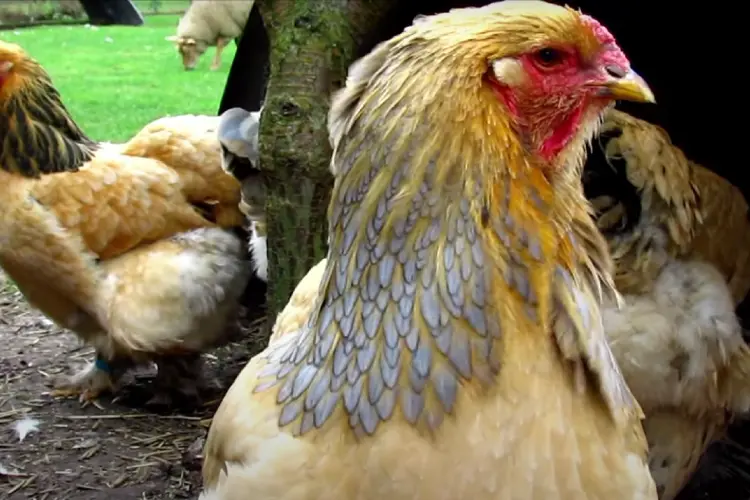
Egg Laying Capacity of Buff Brahma Chicken
Buff Brahma Chickens are moderate egg layers. On average, a Buff Brahma hen will lay about three large brown eggs per week. This amounts to approximately 150 yearly eggs, a modest but reliable production. One of the standout features of this breed is its ability to lay throughout the winter. When many other breeds halt production due to cold weather, Buff Brahma hens often continue, providing a steady supply of eggs.
Buff Brahmas typically begin laying at around five to six months of age (20-24 weeks). This is slightly later than some breeds because they are larger and mature slower. However, once they start, they can maintain a consistent egg-laying pattern.
Some hens can also become broody, especially during the mating season. When they do, they can efficiently incubate and care for their chicks, making them not only good layers but also effective natural mothers. Their large size can cover more eggs, and their docile nature is a benefit when they are brooding.
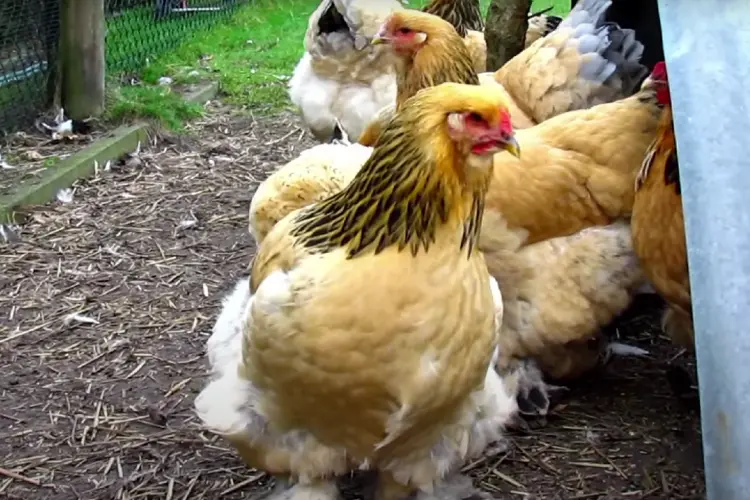
Guide to Caring for Buff Brahma Chicken
Common Health Concerns
Like any poultry, Buff Brahmas are susceptible to parasites like mites and lice, and regular checks are necessary. In addition, due to the heavy feathering around their legs and feet, they’re more susceptible to scaly leg mites.
Keeping their coop clean is essential for their health. Vaccinations and regular health checks should also be part of their care to prevent common diseases like avian influenza and Marek’s disease.
Feeding Practices
Buff Brahmas, due to their large size, require a diet rich in protein. Feeding them a quality layer feed will help ensure they get the nutrients they need. As they’re not as active as smaller breeds, care should be taken not to overfeed them and cause obesity. They will also appreciate occasional treats, scratch grains, and access to a free-range area for foraging.
- For the first few weeks, your Buff Brahma chicks will need a 20% protein chick crumble. This will support their rapid growth and development during this stage.
- Once your Brahmas reach about sixteen weeks old, you can start transitioning them to a 16% protein layer feed. You can choose either crumbles or pellets, depending on what your chickens seem to prefer.
- In addition to their regular feed, Buff Brahmas will need separate bowls for oyster shells and grit. Grit is vital for proper digestion, helping them grind down their food. Oyster shell is a great source of calcium, which helps build strong bones and sturdy egg shells. Avoid adding the oyster shell directly to their feed, as not all birds will require the extra calcium and excessive amounts can cause health issues.
- Clean, fresh water should always be accessible to your Buff Brahmas. It’s vital for their overall health and egg production. Speaking of fresh water, have you ever considered the value of automation? Farmer Brad has designed an automatic chicken waterer that is not only innovative but also extremely practical. You can check it out here.
- During hot summer months, consider adding vitamins and electrolyte powder to their water. This can help them maintain good health and cope with the heat more effectively.
Creating a Cozy Coop
Buff Brahmas need a spacious or wide chicken coop due to their size. While they can tolerate cold, they still need a dry, draft-free environment. Proper ventilation is crucial to avoid respiratory issues. Roosting bars should be lower to the ground and robust enough to accommodate their weight. Also, because of their size, their nesting boxes should be larger than average.
- Space: Each Buff Brahma should be given at least six square feet of coop space, although eight square feet is ideal. This ensures they have enough room to move around comfortably without getting stressed or agitated.
- Coop Modifications: Due to their size (they can reach thirty inches in height), you may need to modify your coop, including the door. A turkey-sized doorway, roughly 12×14 inches, should be adequate for a Buff Brahma.
- Perches: These chickens also require ample space on perches. Allocate about twelve inches of perch space per bird. Since Buff Brahmas are large and heavy, lower perches would be ideal for preventing foot or leg injuries when they jump down.
- Nesting Boxes: Standard-sized nesting boxes may be too small for Buff Brahmas. To make your chicks arrived healthy, the box with a depth and height of twelve inches and a width of fourteen inches should provide enough space for these larger birds to nest comfortably.
Free-range and Exercise Space
While Buff Brahmas are not a highly active breed, they still benefit from free-range areas where they can forage, which also helps prevent obesity. They cannot fly, so fencing doesn’t have to be too high.
However, the outdoor area should be secure from predators. If free-ranging is not an option, providing a large enclosed run will help them get the necessary exercise.

Advantages of Raising Buff Brahma Chicken
Hardiness
Buff Brahma chicken breeds have been bred to survive in various weather conditions. Their large size and dense feathering make them particularly suited to cold climates, as they can keep themselves warm even in lower temperatures. On the flip side, they also handle hot weather surprisingly well. They usually find shady spots during the peak heat and stay hydrated, which aids in their survival in warmer climates.
Size
As one of the heaviest and largest chicken breeds, Buff Brahmas yield a substantial amount of meat. If raised for this purpose, they provide a significant return on investment due to their meat’s quality and quantity. Their size is a testament to their strong genes and good health.
Egg Production
Buff Brahmas are consistent layers, producing a decent number of eggs yearly. The unique aspect is their ability to lay eggs during winter when most other breeds stop. This means you can have a steady supply of eggs all year round, which is not only convenient but can also be economically beneficial.
Temperament
These chickens are known to be calm and friendly. They get along well with other breeds and humans alike, which makes them ideal for mixed flocks and families with children. Despite their large size, they are quite gentle and easy to handle, making them suitable for beginners in poultry farming.
Low Maintenance
They don’t require much in terms of care compared to some other breeds. They’re not known for flying, so you won’t need very high fences. They also have a lower predisposition to many common poultry diseases, so you’ll likely spend less time and money on veterinary care and medications.
Beauty
They are undeniably attractive with their unique coloration and feather patterns. Their regal appearance often makes them a popular choice for poultry shows, and they’re sure to attract attention and compliments in any backyard setting.
Longevity
Brahmas are known for their long lifespan compared to other chicken breeds. This means you can enjoy their company, and eggs, or show potential for a more extended period.
Good Mothers
Buff Brahma hens often show strong, brooding instincts. When they hatch their chicks, they tend to be attentive and protective mothers. This makes them ideal if you’re looking to naturally increase your flock size without the need for artificial incubators.
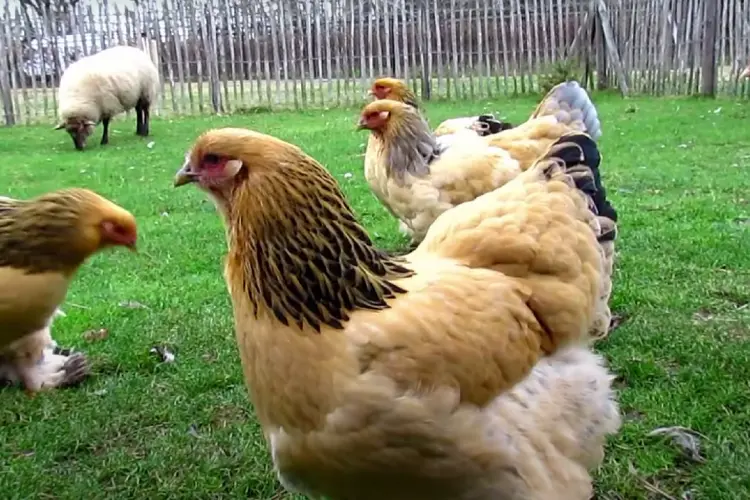
Challenges in Raising Buff Brahma Chicken
Size
As one of the largest chicken breeds, Buff Brahmas need significantly more space than your average chicken. This applies to both their coops and their runs. Providing ample space is crucial for their physical health and mental well-being. Cramped conditions can lead to increased stress, which can reduce egg production and lead to illness. So, if you’re constrained by space, this is something to consider.
Feeding
Buff Brahmas’ large size necessitates a higher food intake than smaller breeds. Over time, this can lead to higher feeding costs. In addition, due to their relatively sedentary nature, care must be taken to avoid overfeeding, which can lead to obesity and associated health issues. Monitoring their diet and ensuring they get enough exercise is key to making healthy birds.
Slow Maturity
Unlike some other breeds that start laying eggs at around 5 months, they are slow growers and may not start laying until around 6-7 months. This slow maturation period might require more patience and resources before you see a return on your investment.
Leg Feathering
The feathering on their legs and feet can be a blessing and a curse. It provides extra warmth in colder climates but can also be a magnet for dirt and parasites, especially in muddy conditions. Regular cleaning of their coop and inspection of their legs and feet will help avoid issues like bumblefoot or scaly leg mites.
Heat Tolerance
Despite their adaptability to various climates, they can struggle in extreme heat due to their thick feathering. Ensuring they have plenty of shade and water during hot weather is essential, and good ventilation in the coop is crucial. Brahmas may also benefit from additional measures to keep cool, like frozen treats or a mister.
Egg Laying
While Buff Brahmas are dependable layers, they won’t give you as many eggs as some of the high-production breeds like Leghorns or Rhode Island Reds. If high egg production is your primary goal, other breeds might be a better fit. However, they can lay throughout the winter, when many other chickens stop laying, which can somewhat offset this disadvantage.
Conclusion
Buff Brahma Chickens are a versatile breed with charm and practical benefits. Their striking appearance, robust size, and gentle demeanor make them a beloved choice for beginners and seasoned poultry enthusiasts. Notwithstanding their unique care requirements – from their need for ample space to their feathered legs needing extra attention – these are largely manageable with proper care.
Their steady egg production, including during winter, and adaptability to various climates, underscore their practical value. Whether you aim to raise them for their eggs, as a meat source, or for their majestic company, Buff Brahmas could be a rewarding addition to your backyard chickens.


